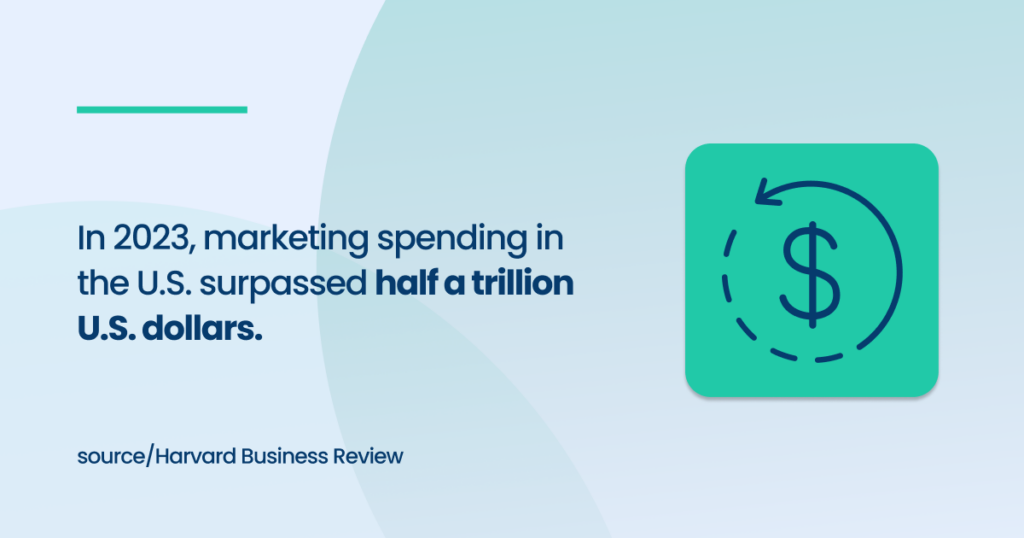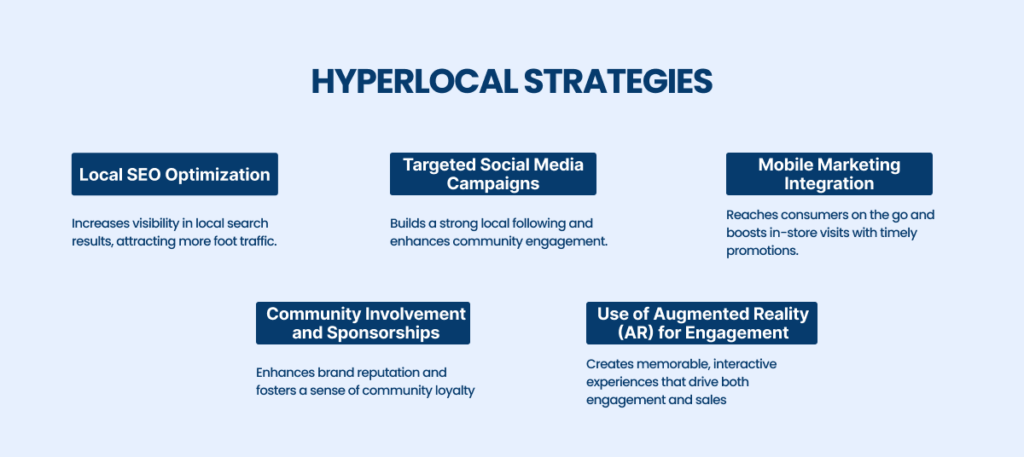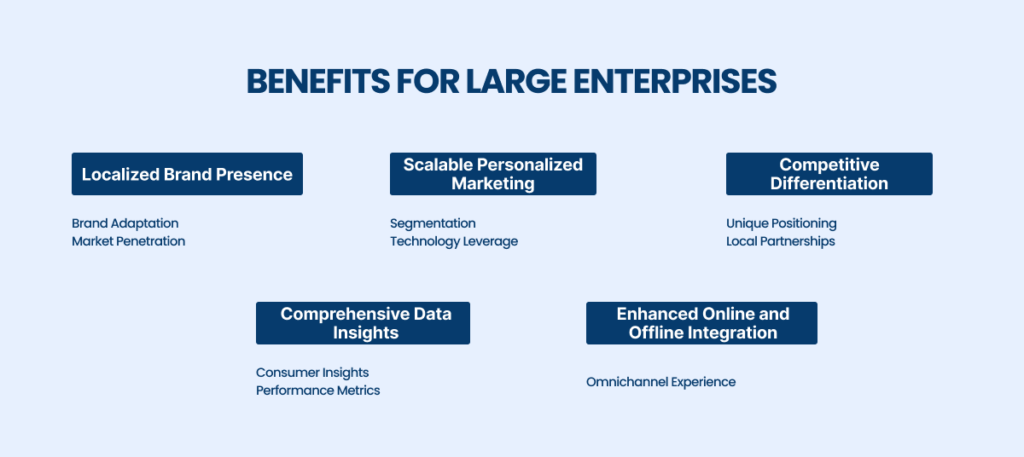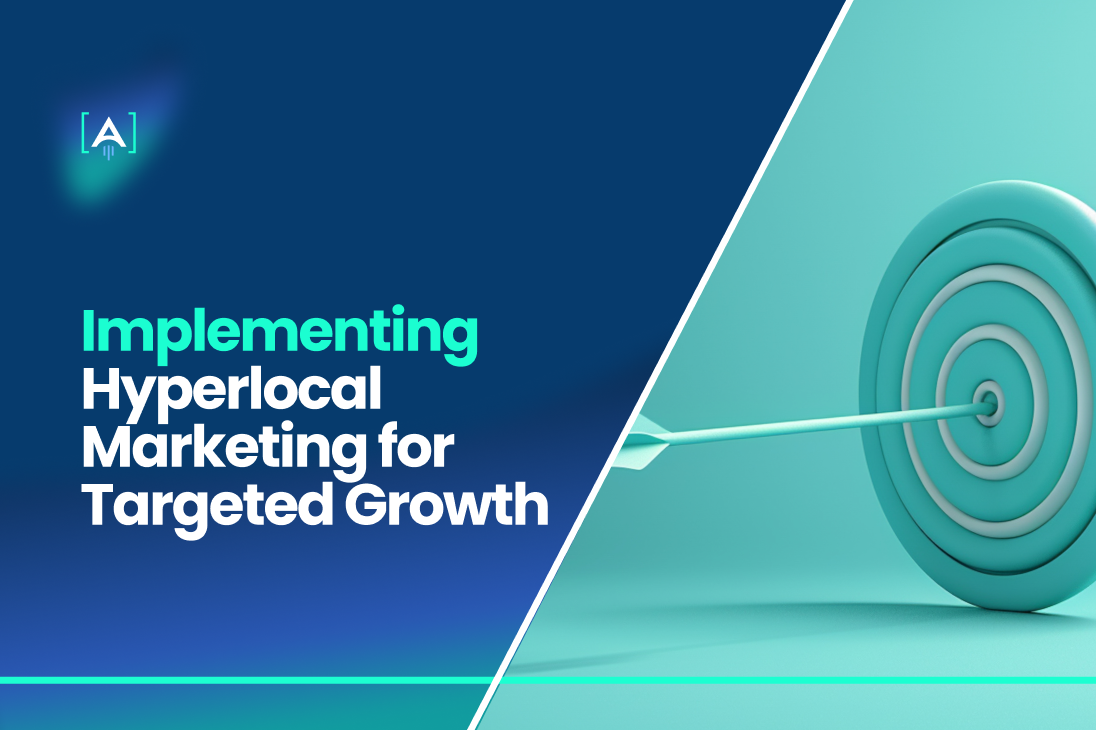The marketing world is full of powerful tools, each with its strengths and applications.
Just like financial markets have derivatives, marketing has a wide array of options—and choosing the right one can make all the difference to your campaign’s success.
A quality growth marketing agency can help you explore the deep world of growth marketing, including hyperlocal marketing.
Partnering with a hyperlocal marketing agency ensures businesses can effectively connect with nearby customers, leveraging location-based strategies for maximum impact.
The blog post explores the concept of hyperlocal marketing, focusing on how businesses can use this approach to achieve targeted growth by connecting with customers in a specific geographical area.
Definition of Hyperlocal Marketing
Hyperlocal marketing is a targeted marketing strategy concentrated on reaching a specific, community-level audience based on their geographical location. It is designed to cater precisely to the local clientele surrounding a business location, leveraging detailed knowledge of the local demographics, preferences, and behaviors.

This approach helps businesses communicate directly with potential customers who are most likely to visit their store or use their services due to proximity.
Key Characteristics of Hyperlocal Marketing:
- Geographical Precision: Hyperlocal marketing targets areas often as small as a neighborhood or even a few blocks. This precision enables businesses to craft highly relevant messages tailored to the local context.
- Local Relevance: Campaigns are designed to resonate deeply locally, incorporating local language, cultural nuances, and community-specific needs, significantly increasing engagement and effectiveness.
- Technology Driven: Utilization of advanced technology such as GPS, location-based services (LBS), and mobile marketing technologies are integral to identifying and targeting users in a specific geographic radius.
- Highly Personalized: The strategy often employs high levels of personalization, appealing directly to local customers’ interests and needs, enhancing conversion chances.
- Community Integration: By focusing on community engagement, hyperlocal marketing often supports or sponsors local events and activities, which helps build a strong local brand presence.
Evolution of Hyperlocal Strategies:
The evolution of hyperlocal marketing strategies has been significantly influenced by technological advancements and changing consumer behaviors.

Here’s a detailed look at how these strategies have evolved:
- From Broad to Specific:
- Early Stages: Initially, local marketing involved broad tactics like distributing flyers and local newspaper ads. These methods targeted general areas without precision.
- Advancements: With the advent of digital technology, businesses started using digital channels to target audiences in specific locales, enhancing the precision and effectiveness of their local marketing efforts.
- Integration of AI and Location-Based Technologies:
- AI marketing: Artificial intelligence has revolutionized hyperlocal marketing by enabling businesses to analyze big amounts of data on consumer behavior and preferences at a local level.
Moreover, AI ROI helps predict patterns that inform more effective targeting and personalization strategies. - Location-Based Services: GPS and other location technologies allow businesses to send marketing messages tailored to the immediate surroundings of the consumer, such as special offers when they are near a store.
- AI marketing: Artificial intelligence has revolutionized hyperlocal marketing by enabling businesses to analyze big amounts of data on consumer behavior and preferences at a local level.
- Growth in Mobile and Social Media Usage:
- Mobile Optimization: As mobile device usage has skyrocketed, hyperlocal strategies have evolved to capitalize on mobile marketing. This includes SMS promotions and location-triggered ads, which reach consumers on their smartphones as they navigate through specific locales.
- Social Media Targeting: Platforms like Facebook and Instagram offer hyper-targeted ad options, allowing businesses to reach potential customers based on specific geographical and demographic data.
- Paid vs. Organic Balancing:
- Paid Campaigns: Search and social media ads can be geotargeted to reach local audiences effectively. These are crucial for quickly boosting visibility in competitive markets.
- Organic Approaches: SEO strategies focusing on local keywords, Google My Business optimization, and community-driven content also form a vital part of hyperlocal marketing, building long-term engagement and trust.
- Experimentation and Adaptability:
- Experimentation Roadmap: Continuous testing and adaptation are key in hyperlocal marketing. Businesses often experiment with different messages, offers, and channels to see what resonates best with the local audience.
- Feedback Loops: Collecting and acting on customer growth and feedback is crucial. This helps businesses adjust their strategies in real-time to meet the needs of local customers better.
- Community-Centric Campaigns:
- Local Events: Participating in or sponsoring local events can significantly boost a business’s profile within a community. Events offer an opportunity for direct interaction with potential local customers.
- Support for Local Causes: Aligning with local causes or community projects can enhance a business’s reputation and foster a sense of community loyalty.
Hyperlocal marketing is more relevant than ever as consumers increasingly look for convenience, personalization, and local options in their shopping habits.
Local businesses can compete effectively by adopting hyperlocal marketing strategies, which means targeting the demographic most likely to convert: the people who live just around the corner.
Importance of Hyperlocal Marketing in Today’s Market
In an increasingly digital world where local relevance and personalized marketing are more important than ever, hyperlocal marketing is a crucial strategy for small and medium businesses and large enterprises.
This marketing approach focuses on tailoring marketing efforts to very specific geographic locales—sometimes as precise as just a few blocks—thereby maximizing the relevance and impact of the messaging to the local community.
This strategy is particularly potent in today’s market environment, where consumers value convenience, locality, and personalized experiences.
Benefits for Small and Medium Businesses
- Increased Visibility in Local Search Results:
- Local SEO: Small and medium businesses benefit immensely from local SEO, which optimizes their online presence to rank higher in local search results. This is critical as many consumers search for services and products using local search terms.
- Google My Business: Using tools like Google My Business, businesses can appear in local directories and maps, significantly increasing their visibility and driving foot traffic.
- Cost-Effective Marketing:
- Targeted Reach: Hyperlocal marketing allows small businesses to target their marketing efforts to the areas where they are most likely to find customers, reducing wastage and increasing the ROI of their marketing spend.
- Community Focus: Engaging with the local community through sponsoring events or participating in local initiatives can be cost-effective to build brand recognition and loyalty.
- Enhanced Customer Relationships:
- Personalization: Small and medium businesses can use their local knowledge to create highly personalized and relevant marketing messages that resonate with the local demographic.
- Customer Feedback: These businesses’ proximity to their customers allows them to gather feedback directly and quickly, enabling them to respond and adapt to customer needs and preferences effectively.
- Agility and Quick Adaptation:
- Local Trends: Being part of the local community gives small businesses the advantage of quickly identifying and capitalizing on local trends.
- Experimentation: Smaller businesses can experiment with new hyperlocal strategies without the bureaucratic red tape that larger companies might face, allowing quicker adaptation and innovation.
Benefits for Large Enterprises

In conclusion, hyperlocal marketing is pivotal for businesses today. It allows them to engage deeply with their target markets by tapping into local communities, enhancing their brand’s relevance, and driving superior marketing performance.
Whether a small local shop aiming to increase foot traffic or a global corporation trying to connect with local markets, hyperlocal strategies offer a tailored, effective way to achieve growth and customer loyalty in an increasingly competitive business environment.
The onboarding process with a skilled marketing agency specializing in hyperlocal strategies can further refine these efforts, ensuring that the strategies are implemented effectively and aligned with broader business goals.
Planning Your Strategies with a Hyperlocal Marketing Agency
Planning effective hyperlocal marketing strategies requires a deep understanding of your local market. This essential step involves meticulous demographic and psychographic analysis and competitive insights.
This knowledge forms the foundation for designing innovative marketing strategies that match with the local audience, optimizing marketing investments, and delivering meaningful engagement right in your business’s backyard.
Understanding Your Local Market
The first step in crafting hyperlocal marketing strategies is to garner in-depth demographic and psychographic insights about the local population. This involves analyzing basic demographic data such as age, gender, income levels, and education, which can be sourced from local government databases or purchased from market research firms.
However, to truly understand the market, one must dig deeper into psychographic data, including lifestyle choices, purchasing behaviors, values, and attitudes. This information can be received through surveys, focus groups, and monitoring social media platforms where local community members are active.
By understanding the demographic makeup and psychographic motivations of their target audience, businesses can connect their messaging and offerings to meet the specific needs and desires of the local community.
Moreover, the use of social media platforms is invaluable in this process.

Source: Hubspot
Platforms like Facebook, Instagram, and Twitter offer tools that allow businesses to analyze trends and preferences within a geographical location. Engaging directly with local customers on these platforms can also provide real-time insights and feedback, enhancing your understanding of the market dynamics.
Demographic and Psychographic Insights
Incorporating demographic and psychographic insights into your strategy allows you to customize marketing messages that speak directly to the local audience’s preferences and pain points.
For example, if your demographic analysis reveals many families in the area, your marketing campaigns can focus on promoting family-friendly products or services.
Similarly, psychographic insights can help you understand the community’s values—perhaps there is a strong lean towards sustainability, making it beneficial to highlight eco-friendly practices or products in your marketing.
Effective hyperlocal marketing strategies often employ hyperlocal ads that are finely tuned to reflect the local populace’s interests, habits, and needs. These ads can be shown on social media platforms, leveraging sophisticated targeting capabilities to ensure they are seen by users in specific localities at specific times, which can significantly increase their relevance and impact.
Competitive Analysis
Another crucial aspect of planning your hyperlocal marketing strategies is performing a thorough competitive analysis. This involves identifying and understanding the local businesses you compete against, including their marketing strategies, product offerings, customer service approaches, and market positioning.
Knowing who your competitors are, what they offer, and how they communicate with the community provides critical insights that can help you differentiate your business and identify gaps in the market.
The competitive analysis should examine how competitors use local events and sponsorships to engage with the community, their presence on local search results, and their performance on local SEO. Analyzing competitors’ customer reviews and social media engagement can also provide a clearer picture of their strengths and weaknesses.
Marketing Agency Onboarding Process
When working with a growth marketing agency to refine your hyperlocal strategy, the marketing agency onboarding process is crucial. It should involve detailed sessions where you share insights gathered from your market understanding and competitive analysis.
The agency can then use this data to formulate more precise marketing strategies tailored to your local market conditions. During the onboarding, asking targeted questions is important to ensure the agency’s approach aligns with your business goals. Questions might include:
- How will they ensure your ads target the correct local audience?
- What innovative marketing strategies do they propose for engaging local customers?
- How will they measure the success of local campaigns?
This stage is about setting the groundwork for a partnership to execute hyperlocal marketing strategies effectively. The agency’s expertise will be leveraged to amplify your business’s local presence and customer engagement.
Future Trends in Hyperlocal Marketing
Hyperlocal marketing continues to evolve rapidly, driven by groundbreaking technological advancements that promise to redefine how local businesses connect with their target customers. Growth marketing agencies are at the core of integrating these technologies into hyperlocal strategies, enhancing the precision and effectiveness of marketing efforts.
The combination of artificial intelligence (AI), machine learning, augmented reality (AR), and virtual reality (VR) in hyperlocal marketing is set to transform the landscape, suggesting innovative ways for businesses to engage with local audiences and improve their local search rankings.
AI and Machine Learning
The use of AI and machine learning in hyperlocal marketing is revolutionizing how businesses target and interact with customers at a local level.

Source: Statista
These technologies allow for the rapid and accurate analysis of large datasets, identifying patterns and trends that human analysts might miss.
For local businesses, this means being able to predict customer behaviors and preferences with a high degree of accuracy and tailoring marketing efforts to effectively meet the specific needs of their local community.
AI algorithms can optimize local search engine optimization (SEO) strategies, ensuring businesses rank higher in local search results. This is achieved by automating keyword research, optimizing local content, and personalizing website user experiences to increase engagement and conversion rates.
Moreover, AI can streamline the customer journey by offering personalized recommendations and promotions based on previous interactions and preferences, significantly enhancing customer satisfaction and loyalty.
Furthermore, machine learning models can continuously learn from new data, allowing local businesses to adapt their marketing strategies in real time. This adaptability is essential in responding to changing local market conditions or customer behaviors, ensuring that marketing efforts remain relevant and effective.
Augmented Reality (AR) and Virtual Reality (VR)
Augmented and virtual reality are set to play pivotal roles in the future of hyperlocal marketing, creating immersive and interactive experiences for customers.

Source: Statista
AR adds a digital layer to the real world, enabling businesses to enhance the physical environment that customers interact with.
For example, a local retailer can use AR to allow customers to visualize how furniture might look in their home before purchasing. This not only improves the shopping experience but also drives engagement and sales.
Virtual reality offers even more profound possibilities by transporting users into virtual environments. For local businesses, VR can be used for virtual tours of a facility or real estate, immersive product demonstrations, or even virtual events. These applications can significantly enhance customer engagement and provide distinctive experiences that elevate a brand above local competition.
Both AR and VR can be particularly effective in driving foot traffic to local stores. By integrating these technologies into mobile apps, businesses can encourage users to visit their stores to unlock certain AR features or promotions, effectively bridging the gap between online interactions and physical retail experiences.
Integrating AR and VR with AI
Integrating AR and VR with AI technologies can further enhance hyperlocal marketing efforts.
AI can analyze user interactions within AR and VR environments to provide insights into user behavior and preferences, which can then be used to further refine the AR/VR experiences. For example, if AI data analysis reveals that customers interact more with certain types of AR content, businesses can focus on developing similar types of content to increase engagement.
Moreover, AI can help personalize AR and VR experiences at the local level, adjusting content and interactions based on individual user data. This personalized approach can make the customer feel uniquely valued and increase brand loyalty, which is crucial for local businesses aiming to stand out in their community.
Partner with [A] Growth for Your Hyperlocal Marketing
Hyperlocal marketing isn’t longer about creating a catchy jingle or flashy ad campaign.
It’s a dynamic force that shapes brand perception, fosters connections, and ultimately fuels business growth. [A] Growth Agency is what you need.
With a finger on the pulse of the latest marketing trends, [A] Growth Agency can help your business stand out in the local market by implementing innovative marketing strategies. We ensure that our experience can help you avoid common pitfalls and accelerate your marketing success.
This partnership could take your local business to the next level!
Go ahead!

